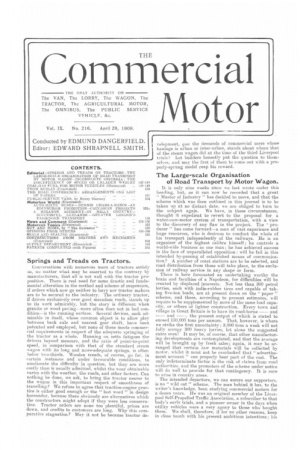Springs and Treads on Tractors.
Page 1

If you've noticed an error in this article please click here to report it so we can fix it.
Conversations with numerous users of tractors satisfy us, no matter what may be asserted to the contrary by manufacturers, that all is not well with the tractor proposition. There is real need for some drastic and fundamental alteration in the method and scheme of suspension, if orders which now go neither to lorry nor tractor makers are to be secured to the industry. The ordinary tractor, if driven exclusively over good macadam roads, stands up to its work admirably, but the story is different when granite or wood paving—more often than not in bad condition—is the running surface. Several devices, each admirable in itself, whose common object is to allow play between back axle and nearest gear shaft, have been patented and employed, but none of these meets commercial requirements in respect of the adequate springing of the tractor as a whole. Running on setts fatigues the drivers beyond measure, and the ratio of point-to-point speed, in comparison with that of the standard steam wagon with its long and more-adequate springs, is often below two-thirds. Wooden treads, of course, go far, in certain instances and under favourable conditions, to ameliorate the difficulty in question, but they are more costly than is usually admitted, whilst the wear obtainable varies with the weather, the roads, and other factors. Can nothing be done, we ask, to bring the tractor nearer to the wagon in this important respect of smoothness of travelling? We refuse to agree that traction-engine practice is either good enough or the " last word" in design hereunder, because there obviously are alternatives which the constructors might adopt if they were less conservative. Tractor orders are none too plentiful, prices are down, and credits to customers are long. Why this cornparative stagnation? May it not be because tractor de
velopment, qua the demands of commercial users whose haulage is urban or inter-urban, stands about where that of the steam wagon did at the time of the third Liverpool trials ? Let builders honestly put the question to themselves, and may the first of them to come out with a properly-sprung model reap his reward.




















